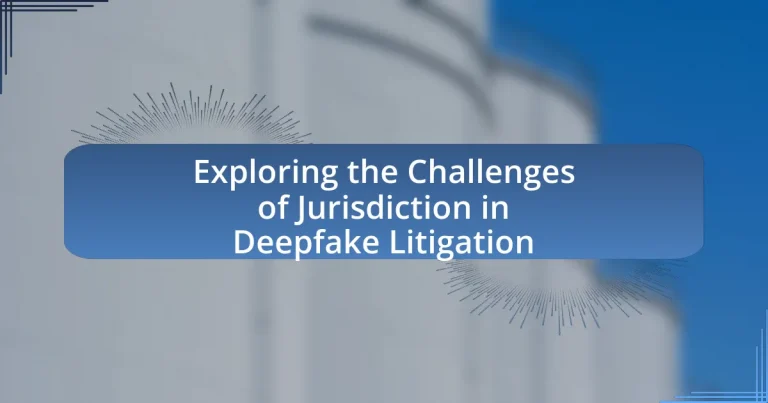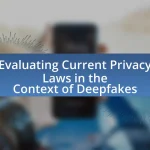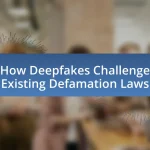The article focuses on the challenges of jurisdiction in deepfake litigation, highlighting the complexities arising from the global nature of digital content and the varying laws across jurisdictions. Key issues include determining the appropriate legal venue, the impact of cross-border dissemination of deepfakes, and the lack of specific laws addressing this technology. The article examines how jurisdiction affects legal proceedings, the types of jurisdiction relevant to deepfake cases, and the implications of jurisdictional ambiguity on enforcement and accountability. It also discusses potential strategies for navigating these challenges and the importance of international cooperation in establishing clearer legal frameworks.
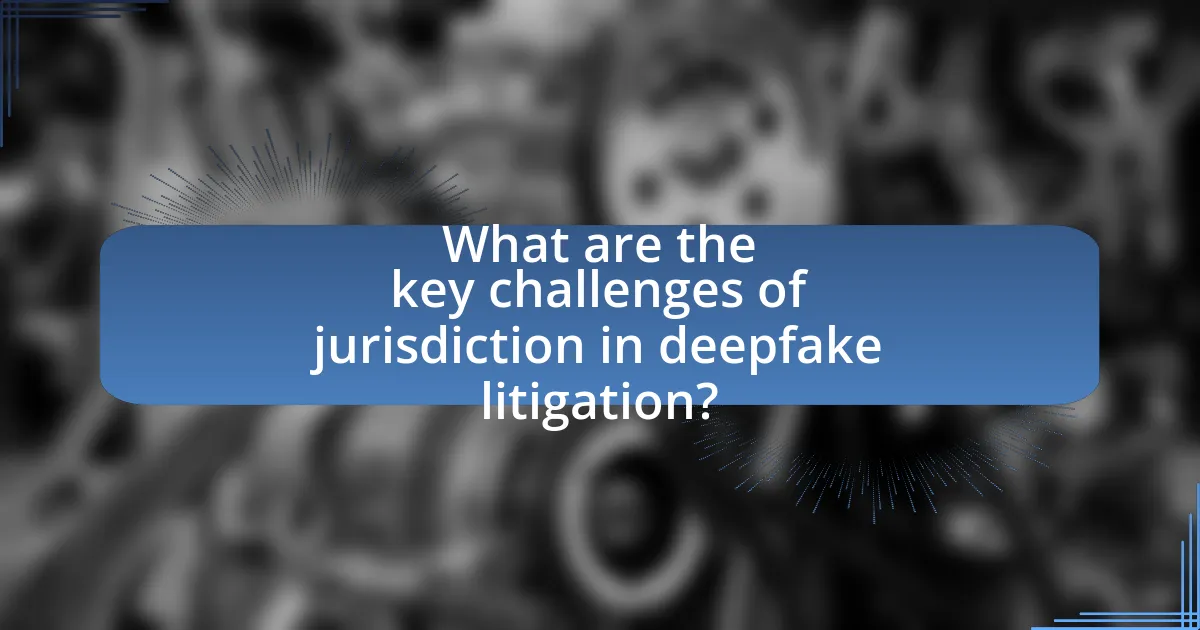
What are the key challenges of jurisdiction in deepfake litigation?
The key challenges of jurisdiction in deepfake litigation include the difficulty in determining the appropriate legal venue, the cross-border nature of digital content, and the varying laws regarding defamation and privacy across jurisdictions. These challenges arise because deepfakes can be created and disseminated globally, complicating the identification of where the harm occurred and which laws apply. For instance, a deepfake video may originate in one country but be viewed in another, leading to conflicting legal standards and enforcement issues. Additionally, many jurisdictions lack specific laws addressing deepfakes, creating uncertainty in legal recourse.
How does jurisdiction impact deepfake cases?
Jurisdiction significantly impacts deepfake cases by determining which laws apply and where legal actions can be pursued. Different jurisdictions have varying laws regarding defamation, privacy, and intellectual property, which can affect the outcome of deepfake litigation. For instance, a deepfake created in one country may violate laws in another, complicating enforcement and accountability. Additionally, the lack of a unified legal framework across jurisdictions can lead to challenges in prosecuting offenders, as seen in cases where perpetrators exploit the differences in laws to evade consequences.
What are the different types of jurisdiction relevant to deepfake litigation?
The different types of jurisdiction relevant to deepfake litigation include personal jurisdiction, subject matter jurisdiction, and territorial jurisdiction. Personal jurisdiction refers to a court’s authority over the parties involved in the litigation, which can be established based on the defendant’s connections to the forum state. Subject matter jurisdiction pertains to the court’s authority to hear the specific type of case, such as tort claims or intellectual property disputes arising from deepfake technology. Territorial jurisdiction involves the geographical area where the court has the power to adjudicate cases, which can be complicated in deepfake cases that may cross state or national boundaries. These jurisdictions are critical in determining where a deepfake lawsuit can be filed and adjudicated effectively.
How do jurisdictional issues complicate legal proceedings in deepfake cases?
Jurisdictional issues complicate legal proceedings in deepfake cases by creating uncertainty about which court has the authority to hear a case. This uncertainty arises because deepfake technology can cross state and national boundaries, making it difficult to determine the applicable laws and regulations. For instance, a deepfake created in one jurisdiction may harm an individual in another, leading to conflicting legal standards and enforcement challenges. Additionally, the lack of established legal precedents specifically addressing deepfakes further complicates jurisdictional determinations, as courts may struggle to apply existing laws to new technological contexts.
Why is jurisdiction particularly complex in the context of deepfakes?
Jurisdiction is particularly complex in the context of deepfakes due to the global nature of the internet and the difficulty in pinpointing the location of the creators and distributors of deepfake content. Deepfakes can be produced and shared across multiple jurisdictions, complicating legal accountability and enforcement. For instance, a deepfake created in one country can be disseminated worldwide, leading to challenges in applying local laws that may not have provisions for such technology. Additionally, existing legal frameworks often struggle to keep pace with the rapid evolution of digital content creation, resulting in ambiguities regarding which jurisdiction’s laws apply. This complexity is further exacerbated by varying definitions of defamation, privacy rights, and intellectual property laws across different regions, making it challenging to establish a clear legal pathway for litigation.
What role does the internet play in jurisdictional challenges for deepfake litigation?
The internet complicates jurisdictional challenges in deepfake litigation by enabling the rapid dissemination of content across borders, making it difficult to determine which legal framework applies. This global reach means that deepfake materials can originate in one jurisdiction but impact individuals in another, leading to conflicts between local laws and international regulations. For instance, a deepfake created in one country may violate privacy laws in another, creating ambiguity about which court has authority to adjudicate the case. Additionally, the anonymity provided by the internet can hinder the identification of responsible parties, further complicating jurisdictional claims.
How do varying laws across jurisdictions affect deepfake cases?
Varying laws across jurisdictions significantly impact deepfake cases by creating inconsistencies in legal definitions, enforcement, and penalties. For instance, some jurisdictions may classify deepfakes as a form of fraud or defamation, while others may not have specific laws addressing them, leading to challenges in prosecution. Additionally, the lack of a unified legal framework can result in offenders exploiting these differences to evade accountability, as seen in cases where individuals use deepfakes for malicious purposes without facing legal repercussions in lenient jurisdictions. This disparity complicates the ability of victims to seek justice and highlights the urgent need for harmonized legislation to effectively address the unique challenges posed by deepfakes.
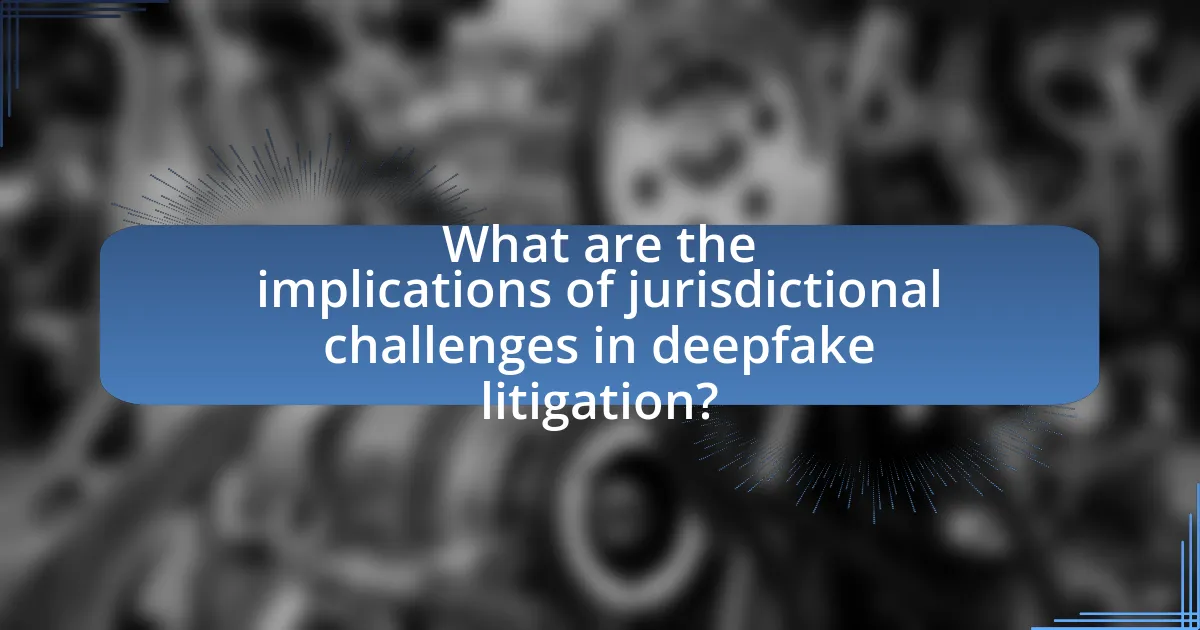
What are the implications of jurisdictional challenges in deepfake litigation?
Jurisdictional challenges in deepfake litigation can lead to significant complications in enforcing legal accountability. These challenges arise because deepfakes can be created and disseminated across multiple jurisdictions, making it difficult to determine which laws apply and where a case should be filed. For instance, if a deepfake is produced in one country but harms an individual in another, conflicting laws regarding defamation, privacy, and intellectual property may complicate legal proceedings. Additionally, the lack of a unified legal framework for deepfakes exacerbates these issues, as different jurisdictions may have varying standards for evidence and liability. This complexity can result in prolonged legal battles, increased costs for plaintiffs, and potential gaps in protection for victims, ultimately undermining the effectiveness of legal recourse in addressing deepfake-related harms.
How do jurisdictional issues affect the enforcement of legal decisions?
Jurisdictional issues significantly hinder the enforcement of legal decisions by creating barriers to recognition and execution across different legal systems. When a court issues a ruling, its authority may not extend beyond its geographical or legal boundaries, leading to complications when the parties involved are located in different jurisdictions. For instance, if a court in one country rules against a defendant who resides in another country, the enforcement of that ruling may require additional legal proceedings in the defendant’s jurisdiction, which may not recognize the original court’s authority. This situation is particularly relevant in deepfake litigation, where the technology’s global nature often involves parties from multiple jurisdictions, complicating the enforcement of legal decisions and potentially leading to inconsistent outcomes.
What are the consequences of a lack of clear jurisdiction in deepfake cases?
The consequences of a lack of clear jurisdiction in deepfake cases include legal ambiguity, inconsistent enforcement of laws, and challenges in holding perpetrators accountable. Legal ambiguity arises because different jurisdictions may have varying definitions and regulations regarding deepfakes, leading to confusion about which laws apply. Inconsistent enforcement occurs when some regions may prosecute deepfake-related offenses while others do not, creating a patchwork legal landscape. This inconsistency can hinder victims from seeking justice and may embolden offenders who exploit jurisdictional gaps. Furthermore, without clear jurisdiction, international cooperation in prosecuting cross-border deepfake cases becomes complicated, as countries may have differing legal frameworks and priorities.
How can jurisdictional ambiguity lead to forum shopping in deepfake litigation?
Jurisdictional ambiguity can lead to forum shopping in deepfake litigation by allowing plaintiffs to choose jurisdictions that may be more favorable to their cases. This ambiguity arises from the complex nature of deepfake technology, which often crosses state and national boundaries, making it unclear which court has the authority to hear a case. For instance, if a deepfake is created in one jurisdiction but distributed in another, the plaintiff may seek a venue perceived as more sympathetic to their claims, such as one with stronger privacy laws or more lenient standards for proving harm. This behavior is supported by the fact that different jurisdictions can have varying legal standards and remedies available for deepfake-related harms, incentivizing litigants to strategically select courts that align with their interests.
What strategies can be employed to navigate jurisdictional challenges?
To navigate jurisdictional challenges in deepfake litigation, parties can employ strategies such as establishing clear legal frameworks, utilizing international treaties, and leveraging technology for evidence collection. Establishing clear legal frameworks involves defining jurisdictional boundaries and applicable laws specific to deepfake cases, which can help mitigate confusion and conflicts. Utilizing international treaties, such as the Hague Convention, can provide a basis for cooperation between jurisdictions, facilitating smoother legal processes. Additionally, leveraging technology for evidence collection, such as blockchain for authenticity verification, can strengthen cases and clarify jurisdictional issues. These strategies are supported by the increasing complexity of digital content and the need for cohesive legal standards across jurisdictions.
How can legal practitioners prepare for jurisdictional issues in deepfake cases?
Legal practitioners can prepare for jurisdictional issues in deepfake cases by thoroughly understanding the legal frameworks governing digital content across different jurisdictions. This preparation involves researching the specific laws related to defamation, privacy, and intellectual property in the relevant jurisdictions, as deepfake technology often crosses state and national borders. Additionally, practitioners should stay informed about recent case law and regulatory developments that address deepfakes, as these can influence jurisdictional determinations. For instance, the 2021 case of “Doe v. MySpace” highlighted the complexities of jurisdiction in online content disputes, emphasizing the need for legal professionals to be adept at navigating both local and international legal landscapes.
What best practices can be adopted to address jurisdictional complexities?
To address jurisdictional complexities in deepfake litigation, adopting a multi-jurisdictional legal strategy is essential. This involves understanding and integrating the laws of different jurisdictions where the deepfake content may be accessed or distributed. For instance, legal practitioners should familiarize themselves with the varying definitions of defamation, privacy rights, and intellectual property laws across jurisdictions, as these can significantly impact case outcomes. Additionally, establishing clear jurisdictional clauses in contracts can help mitigate disputes by specifying which laws govern the agreement. Research indicates that jurisdictions with robust digital privacy laws, such as the European Union’s General Data Protection Regulation, provide a framework that can be leveraged in litigation to protect individuals from harmful deepfake content.

What future trends may influence jurisdiction in deepfake litigation?
Future trends that may influence jurisdiction in deepfake litigation include the increasing use of artificial intelligence in content creation, the development of international legal frameworks, and the rise of decentralized platforms. The proliferation of AI technologies enables the creation of more sophisticated deepfakes, complicating the identification of jurisdiction as these technologies often operate across borders. Additionally, as countries recognize the need for cohesive legal standards, international treaties and agreements may emerge, providing clearer guidelines for jurisdiction in cases involving deepfakes. Furthermore, the growth of decentralized platforms, which can obscure the origin of content, poses challenges for traditional jurisdictional approaches, necessitating new legal interpretations and frameworks to address these complexities.
How might evolving technology impact jurisdictional frameworks?
Evolving technology significantly impacts jurisdictional frameworks by challenging traditional legal boundaries and necessitating new regulatory approaches. As digital platforms and technologies like deepfakes transcend geographical limits, they complicate the enforcement of laws that are typically bound by jurisdictional lines. For instance, the rise of deepfake technology has led to instances where harmful content can originate in one country but affect individuals in another, creating a legal grey area regarding which jurisdiction’s laws apply. This situation has prompted legal scholars and policymakers to advocate for updated frameworks that can address cross-border issues effectively, as evidenced by discussions in the European Union regarding the Digital Services Act, which aims to create a more cohesive regulatory environment for online content.
What potential legal reforms could address jurisdictional challenges in deepfake cases?
Potential legal reforms to address jurisdictional challenges in deepfake cases include the establishment of a uniform legal framework that defines jurisdiction based on the location of the victim, the perpetrator, or the platform hosting the content. This reform could facilitate cross-border cooperation and streamline the legal process, as deepfake technology often transcends geographical boundaries. Additionally, implementing specific laws that categorize deepfakes as a distinct form of digital harm could provide clearer jurisdictional guidelines. For instance, the proposed “Deepfake Accountability Act” in the United States aims to create a legal basis for prosecuting malicious deepfake creators, thereby clarifying jurisdictional issues. Such reforms would enhance the ability of courts to adjudicate cases effectively, ensuring that victims have access to justice regardless of where the deepfake was created or disseminated.
How can international cooperation improve jurisdictional clarity in deepfake litigation?
International cooperation can improve jurisdictional clarity in deepfake litigation by establishing standardized legal frameworks and protocols across countries. Such collaboration enables nations to align their laws regarding deepfake technology, facilitating a more coherent approach to identifying jurisdiction in cases involving cross-border deepfake incidents. For instance, the European Union’s General Data Protection Regulation (GDPR) has set a precedent for data protection laws that can be adapted to address deepfake issues, promoting consistency among member states. This alignment reduces ambiguity in legal proceedings, allowing for more efficient enforcement and adjudication of deepfake-related cases, thereby enhancing legal predictability and accountability.
What practical steps can individuals take to protect themselves from deepfake-related legal issues?
Individuals can protect themselves from deepfake-related legal issues by actively monitoring their online presence and utilizing digital rights management tools. Regularly searching for their images and videos online helps individuals identify unauthorized deepfakes. Additionally, employing watermarking techniques on personal media can deter misuse. Legal measures, such as understanding and utilizing existing laws against defamation and identity theft, provide a framework for action if deepfakes are used maliciously. Furthermore, individuals should consider consulting with legal professionals who specialize in digital media to stay informed about evolving laws and best practices. These steps are essential as deepfake technology poses significant risks, with a 2020 report indicating that 96% of deepfakes are used for non-consensual pornography, highlighting the urgent need for protective measures.
How can individuals ensure they are aware of jurisdictional implications when dealing with deepfakes?
Individuals can ensure they are aware of jurisdictional implications when dealing with deepfakes by researching the specific laws and regulations governing digital content in their jurisdiction. Understanding that laws regarding deepfakes vary significantly across regions is crucial; for instance, some jurisdictions may have specific statutes addressing the creation and distribution of deepfakes, while others may rely on existing laws related to defamation, privacy, or intellectual property. Additionally, consulting legal experts who specialize in digital media law can provide tailored insights into how jurisdictional issues may affect individual cases involving deepfakes. This approach is supported by the fact that legal frameworks are continually evolving to address the challenges posed by emerging technologies, including deepfakes, as highlighted in various legal analyses and case studies.
What resources are available for understanding jurisdiction in deepfake litigation?
Resources available for understanding jurisdiction in deepfake litigation include legal journals, case law databases, and specialized reports from organizations focused on technology and law. Legal journals such as the Harvard Law Review and the Yale Law Journal often publish articles analyzing jurisdictional issues related to emerging technologies, including deepfakes. Case law databases like Westlaw and LexisNexis provide access to relevant court decisions that illustrate how jurisdictions are handling deepfake cases. Additionally, reports from organizations like the Electronic Frontier Foundation and the Berkman Klein Center for Internet & Society offer insights into the legal challenges posed by deepfakes, including jurisdictional considerations. These resources collectively provide a comprehensive understanding of the complexities surrounding jurisdiction in deepfake litigation.
